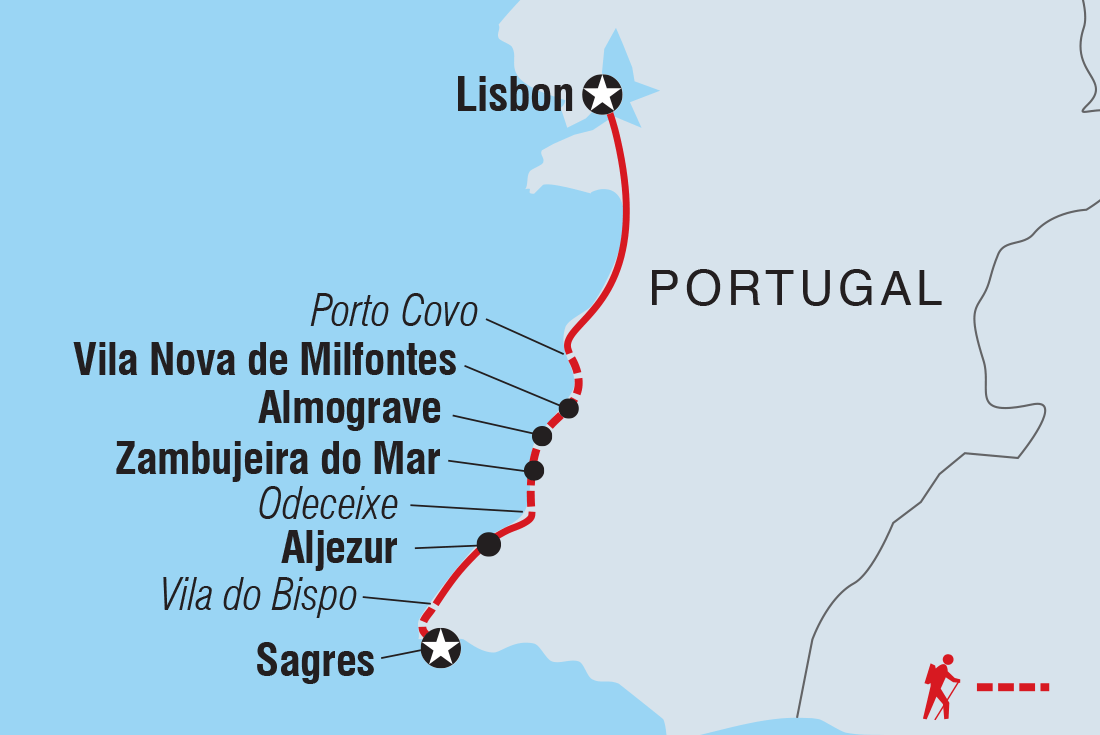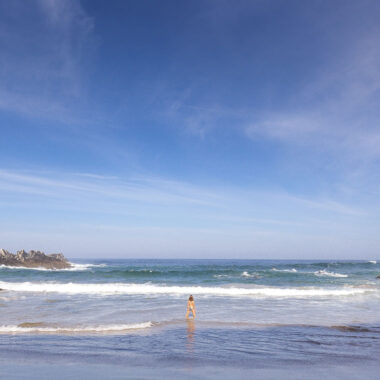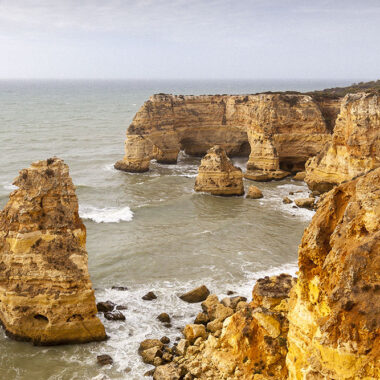The last day of our time in Costa del Sol on Spain’s southern coast marked the expiry of our three month Eurail passes. Amazing to think we left California that long ago! With no rail passes in our pockets we were free to choose the best route from Málaga to Portugal. Given Málaga is only about 170 miles/270 kilometers from the Portuguese border one would think it pretty straightforward to get between the two. Not so. It was going to be roughly 12 hours on a train or about the same amount of time on a bus to get fromMálaga to Lisbon. A car would have been an option, but there was going to be a $500 premium attached to a one way rental between the two countries. Ryanair to the rescue with a twice-weekly route betweenMálaga and Lisbon! While the timing wasn’t great – our flight left at 6:30AM so we all had to rise at 4:30AM to make it to the airport – Lisa and I weren’t complaining when the tickets only cost us $18 a piece! There’s a lot of griping online about Ryanair, but we were all quite pleasantly surprised: clean planes, efficient check in, very friendly staff and the plane actually left 15 minutes early. I think a lot of travelers fail to read Ryanair’s terms and conditions, and in doing so get whacked with multiple fees when they arrive at the airport. For example, if you fail to declare and book your checked luggage more than two hours before your flight it’s incredibly expensive to do so at the airport. Another one is boarding passes: fail to check in with the Ryanair app or print your boarding passes more than two hours before your flight and it’s a whopping 45€ each for the Ryanair staff to check you in and give you boarding passes at the airport.
Get Directions
With no rail passes – a lot of the places we want to visit in Portugal aren’t accessible by train anyway – we grabbed a rental car at Lisbon’s Humberto Delgado Airport and started our journey south. Portugal’s not a large country and we plan to explore most of its western portion, but we started with the southern Alentejo and Vicentina coasts given the weather was forecast to allow us some more beach days before less-than-favorable weather was due in southwestern Europe a few days after our arrival in Lisbon. The coastline south of Lisbon pretty much all the way to Portugal’s most southwesterly tip is almost completely undeveloped, most of it part of the Southwest Alentejo and Vicentine Coast Natural Park. The port city of Sines – where we stopped for a break on our drive south – marks the northern end of the Rota Vincentina hiking trails, the most famous of which is the Fisherman’s Trail. TheFisherman’s Trail is a 227 kilometer/141 mile hiking route traversing the coastline fromPorto Covo all the way to Odeceixe near Portugal’s southwestern tip and injects a lot of tourism dollars into the tiny fishing and agricultural villages along the coast south of Sines.

The stretch of coastline south of Sines to Portugal’s southwestern tip was easily one of the most visually stunning I’d ever had the fortune to experience. It was like a mashup of Victoria’s Great Ocean Road and Yorke Peninsula’s Innes National Park: untouched stretches of rugged limestone cliffs and pristine beaches tucked below, with charming whitewashed villages scattered between. We stopped off at Praia de Sao Torpes just south of Sines on our route south to watch the surfers, after which we had a quick stroll around Porto Covo before continuing our drive south. Max was very disappointed the remote surf school next toPraia de Sao Torpes didn’t have any kids sized wetsuits or boards, otherwise I think he would have been in the water there all day.
We had some time to kill on the way to our destination of Almograve, so enjoyed a few hours swimming at the secluded and almost completely deserted Praia do Malhão on our route south. Our first swim of many on Portugal’s southwestern coast had both Lisa and me drawing so many comparisons to the coastline of southern Australia: the cliffs, surfers in the ocean, the color of the sand, even the temperature of the water… It was an exceptional spot to spend a few hours during the middle of the day until the mercury started to drop. Sandwiches on the beach with a some Aerobie pinging and a couple of swims, can’t ask for more than that. About the only people other than us in the water along theAlentejo coast were surfers enjoying what looked to be some exceptional waves. I ventured out into the deep for some bodysurfing but was quickly taught a lesson about just how punchy the breaks are. Lisa told me after the fact she was a little worried about me out there, but kept telling herself that I knew what I was doing!








The Alentejo coastline was a very agriculture-centric region of Portugal. Effectively the entire stretch of the coast had farmland jutting all the way up to the sand dunes. The small villages dotted along the coast provided housing for the agricultural community and also served as waypoints for hikers traversing the Fisherman’s Trail. We spent our time on theAlentejo coast in the quaint agricultural village of Almograve, tucked in behind the sand dunes a few hundred meters from the ocean. Almograve couldn’t have had more than a few hundred full time residents housed in its collection of whitewashed villas, the kind of town where everyone knows everyone. All the weathered old Portuguese men that swarmed like bees to the town’s drinking establishment to suck down a few Super Bocks each afternoon were classic. The town center had a couple of main streets and three minimarts, as well as four or five hole-in-the-wall restaurants (it was a bit of a roll of the dice figuring out which one was going to be open for dinner each night during our stay!). Our AirBNB was a fantastic spot, a stone’s throw from the dunes and the small collection of cafes and restaurants, with a yard where Max amused himself with his soccer ball and a great little wood pellet stove to keep us all warm in the evening hours. Our dinner at Torralta across the street from our AirBNB was a fun evening, such yummy food, the octopus rice was absolutely delicious. We also strolled to the outskirts of Almograve one evening to a Nepalese restaurant run by a family who moved to Portugal a few years ago to pick berries and sweet potatoes in the surrounding farmland. Max was very impressed with the son’s ability to speak four languages (and the curries were exceptional).










As on Costa del Sol, days spent entirely in bathing suits are always very much enjoyed by the four of us. We managed it again on the Alentejo coast with a morning swim and packed lunch at Praia do Cavaleiro followed by the afternoon at Praia do Almograve just below the village of Almograve. Praia do Cavaleiro was such a dramatic spot, flanked by towering cliffs with a precarious trail winding down to the beach. I’ll let the photos below do most of the talking, but I will note again just how stunning the beaches and cliffs were in this region of Portugal. God’s country. And so wonderful that it’d all been left completely undeveloped. If the weather had been forecast to cooperate – there was a big storm in the forecast the day after we left the area – I’m pretty sure we all could have easily enjoyed a week on theAlentejo coast.
We were all sad to bid goodbye to Almograve, it was one of those places where life slowed down and we had the chance to enjoy it all. It was another roughly 90 minutes-or-so to Portugal’s southwestern tip at Sagres, which is home to the famous Sagres Fortress as well as a smattering of beautiful beaches. We enjoyed lunch while watching the surfers at Praia da Mareta and then spent an hour or so strolling through the grounds of the fortress. The fortress was quite a sight to behold, for centuries the main battleground of a maritime defensive system that guarded Portugal’s border on the Mediterranean. The limestone cliffs on which the fortress was built dropped more than 200 feet/60 meters into the ocean below, I was astonished to see a handful of weathered local fisherman perched on their edge with bobber-tackled fishing line extending to the ocean below. I watched a few of them for a while, hoping to see just how they managed to reel in a furiously-wiggling fish from the surface up200 feet/60 meters to the top of the cliffs. More surf breaks on the Atlantic and Mediterranean sides of Sagres, there were a handful of learners on the sheltered Mediterranean side (first few photos below) and a lone gun in the furious swell of the Atlantic on Praia do Tonel. The surfer at Praia do Tonel honestly looked like a rice bubble in a washing machine, but he still managed to navigate the surf and catch a few of the huge waves pummeling the cliffs.
A stunning part of the world, one I’d definitely like to revisit sometime during the warmer months of the year. If I do manage to return, I’m pretty sure I’d have a few more Valtenbergs requesting to join me!


































































Beautiful swells and sea with so much to explore.
Pingback: The Algarve - Our Walkabout Two